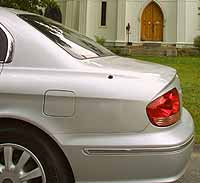2002 Hyundai Sonata Program #2127
When Hyundai first entered the American market in 1986 with a subcompact called Excel, the general response from a market flooded with small cars was why? But the plucky little Korean car company overcame critics, buyer resistance, and poor quality to become the fifth largest import brand in America. Today, Hyundai offers six model ranges, including the redesigned Sonata sedan, all with the longest warranties in the business: 5 years/60,000 miles on the vehicle, and 10 years/100,000 miles on the powertrain. But is a great warranty enough reason to buy a new Sonata?
We don’t think so. But, to back up that impressive warranty, Hyundai has given the almost mid-size Sonata a thorough revamp for the 2002 model year.
Changes start with the sheet metal. The front end leads with a more upscale waterfall- style grille and artful dual-lens headlamps. Fog lamps are now standard, as well. All this fronts a new sleeker, high center hood. The Sonata’s tail has also been revised, with more curvaceous Jaguar-style fenders, deck lid, and taillights.
 The Sonata platform retains its 106.3-inch wheelbase, but now rides on either the base model’s standard 15-inch alloy wheels, or our GLS test car’s larger 16-inch design. To improve chassis performance, Hyundai engineers have retained last year’s double- wishbone front suspension, but lowered the suspension mounting points and shock mounts of the multi-link rear.
The Sonata platform retains its 106.3-inch wheelbase, but now rides on either the base model’s standard 15-inch alloy wheels, or our GLS test car’s larger 16-inch design. To improve chassis performance, Hyundai engineers have retained last year’s double- wishbone front suspension, but lowered the suspension mounting points and shock mounts of the multi-link rear.
They’ve also given the GLS and LX models some extra kick, with a new 2.7-liter dual- overhead-cam 24-valve Delta V6, borrowed from the Santa Fe sport-ute. It makes 181 horsepower and 177 pound-feet of torque. That’s 11 horsepower and 11 pound-feet of torque over last year’s smaller 2.5-liter V6. Base cars continue to use a 2.4-liter dual-overhead-cam 16-valve 4-cylinder that makes 149 horsepower and 156 pound-feet of torque. It too is sourced from the Santa Fe.
Transmission choices remain a base 5-speed manual, or our car’s available 4-speed automatic, with Shiftronic manual-mode operation. Which, coupled to the V6 engine, can master 0-60 in 8.5 seconds, and runs the full 1/4 mile in 16.4 seconds with a terminal speed of 87 miles-per-hour. Bottom end power is very soft by V6 standards, but the engine feels much more refined than earlier Delta-series powerplants. The transmission feels solid enough, but with the revs up high it couldn’t be manually downshifted for passing.
In our handling test, the Sonata feels little different from previous models. Front end push is still heavy, and the slow power rack-and-pinion steering delivers little feedback. There’s actually plenty of grip, but the slow handling and prominent body roll make it feel otherwise. On the other hand, this year’s suspension changes have resulted in substantially improved ride quality. So while still a long way from a sport sedan, the Sonata is now a much more enjoyable day-to-day driver than before. And still reasonably economical. EPA mileage ratings are 20 city/27 highway. We averaged 22 miles-per-gallon in our economy loop.
As for braking equipment, that’s unchanged for 2002, with our GLS carrying standard 4- wheel discs. Stops from 60 averaged a longish 130 feet, with noticeable pedal fade, and a loss of feel after a few runs. Stability was, however, good, and we recommend the optional ABS for best control.
In the interior department, the 2002 Sonata offers a host of safety features. They include seat-mounted side airbags, automatic seat belt pretensioners, and Hyundais’ Passenger Presence Detection system, which prevents the right front passenger airbag from deploying if the seat is occupied by a child. Regardless of trim level, the interior is very well equipped, with everything from air conditioning to a CD-stereo, though interior plastics are still a bit too utilitarian And our car’s AM/FM/Cassette/CD stereo had a weak, tinny sound. It’s a unit that will quickly be replaced by many owners. On the plus side, controls for both the stereo and climate system are clear and well laid out.
Front and rear seating offers improved comfort and support. We’d still like some more rear leg room, but we can get by with what’s available. But while interior room is little changed, the trunk space has grown to a usable 14.1 cubic-feet.
The Sonata’s base price has also grown slightly, and now stands at $15,994 for a 4- cylinder manual. The price for a GLS V6, however, is unchanged, holding steady at $17,494. The new-for-2002 LX model starts at $18,819. The LX adds leather, a power driver’s seat, and automatic temperature controls. You’d pay about $3,800 more for a comparable, if slightly larger and more refined, Honda Accord.
So back to our original question. Is having a great warranty enough reason to buy the Sonata? No. But add in continuous improvements, handsome styling, capable if average performance, and more comfort, convenience, and safety features than you’d ever expect for its bargain prices, and we think most people will see more than enough reasons to buy a 2002 Hyundai Sonata.
Specifications
- Engine: 2.7-Liter Dohc 24-valve Delta V6
- Horsepower: 181
- Torque: 177 Lb Feet
- 0-60 MPH: 8.5 Seconds
- 1/4 Mile: 16.4 Seconds @ 87 MPH
- 60-0 MPH: 130 Feet
- EPA Mileage: 20 MPG City 27 MPG Highway






